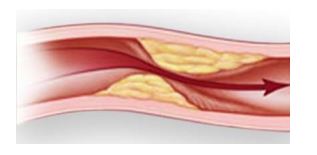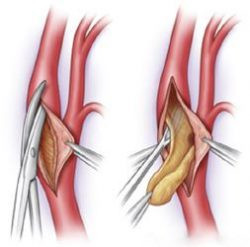WHAT IS CLAUDICATION?
Claudication is pain, tired or weak feeling that occurs in your legs, usually during activity such as walking. The symptoms typically begin when you start to exercise, and go away a short time after you rest.
Your arteries carry blood rich with oxygen and nutrients from your heart to the rest of your body. When the arteries that carry blood to your legs become narrowed or blocked, your leg muscles may not receive enough of the blood and oxygen they need to support physical activity. Physicians call this lack of oxygen ischemia. Initially, your legs may receive enough blood while you are at rest so that you do not experience any discomfort without activity.
However, your muscles need more oxygen when you exercise, so if the arteries in your legs are narrowed to the point that too little blood reaches your muscles, you may feel leg pain when you walk. Claudication, which physicians also call intermittent claudication because it happens off and on, is a serious warning symptom because people who have it are also at increased risk for heart attack and stroke.
Your arteries are normally smooth and unobstructed on the inside but, as you age, they can become blocked through a process called atherosclerosis, also called “hardening of the arteries.” As you age, a sticky substance called plaque can build up in the walls of your arteries. Plaque is made up of cholesterol, calcium, and fibrous tissue. As more plaque builds up, your arteries can narrow and stiffen. Eventually, enough plaque builds up to reduce blood flow to your leg arteries. Physicians call this condition peripheral arterial disease (PAD).

WHAT ARE THE SYMPTOMS?
Claudication is discomfort or pain in your legs that happens when you walk and goes away when you rest. You may not always feel pain; instead you may feel a tightness, heaviness, cramping, or weakness in one or both of your legs. Claudication often occurs more quickly if you walk uphill or up a flight of stairs. Over time, you may feel claudication at shorter walking distances, as the degree of artery blockage worsens.
WHAT CAUSES CLAUDICATION?
Claudication is a symptom of PAD, which is caused by atherosclerosis.
Risk factors for atherosclerosis include:
- Smoking
- High cholesterol levels in the blood
- High blood pressure
- Obesity
- Having a family history of heart or vascular disease
WHAT TESTS WILL I NEED?
First your physician will ask you questions about your general health, medical history, and symptoms. In addition, your physician will conduct a physical examination. Together these are known as a patient history and exam. As part of your history and exam, your physician will want to know if you smoke or have high blood pressure. Your physician will also want to know when your symptoms occur and how often as well as their location. As part of the physical exam, your physician will conduct pulse tests, usually by feeling the pulses at various locations, to assess the strength of the circulation in your leg arteries. Your physician may also use a stethoscope to listen to the blood flowing through your leg arteries. Since PAD can affect any artery in the body, your physician will usually check arteries in other locations in your body besides your legs.
After your exam, if your physician suspects PAD, he or she may perform some tests, such as:
- Ankle-brachial index (ABI), which compares the blood pressure in your arms and legs
- Pulse volume recording, which measures the volume of blood at various points in your legs
- Duplex ultrasound
- Blood tests for cholesterol, high blood sugar or other markers for artery disease
- Magnetic resonance angiography (MRA)
- Computerized tomographic angiography (CTA)
- Angiography
Physicians usually begin with the noninvasive tests and reserve more invasive tests, such as angiography, for people with more severe forms of PAD requiring intervention or surgery.
HOW IS CLAUDICATION TREATED?
Treatment of underlying causes of PAD
Although your physician will treat your claudication, he or she will also treat the underlying causes of your PAD, such as high cholesterol or high blood pressure. Treatment for these conditions includes lifestyle changes such as smoking cessation, exercise and weight loss, medication, and, if necessary, endovascular intervention or surgery.
Exercise therapy
Exercise therapy is the initial treatment for claudication. Your physician will develop an exercise plan specifically for you. The plan may include what type of exercise to do, how hard you should exercise, how long, and how many times per week you should exercise. Therapeutic exercise recommendations for claudication generally consist of walking for periods of 1 hour or more, 3 or more times per week, for at least 3 to 6 months, ideally under medical supervision. The aim is to increase the amount of time that you can walk without reproducing severe pain in your legs. You will gradually accomplish this by walking for longer and longer periods.
At first, you should walk until you experience claudication pain, usually between 3 and 5 minutes after you begin walking. You should then continue walking until the pain becomes moderate (on a scale of 1 to 5, the pain is 3), which is usually at around 8 to 10 minutes of walking. Then you should stop walking and rest until the pain goes away, at which point you should begin walking again. Repeat this cycle of exercise and rest for approximately 35 minutes at the beginning and gradually increase the time until you can walk up to a total of 50 minutes. A sign that you are making progress in your walking program is that you will be able to walk for longer periods without pain.
Medications
Your physician may also prescribe medications such as cilostazol (Pletal), which sometimes can help improve the distance you are able to walk without discomfort or pain. This medication may not be helpful, however, if you have certain heart conditions. Your physician will help you decide what is best for your particular situation.
If appropriate, your physician may suggest medications such as statins, to help control your blood lipid (fat) levels, medication to control high blood pressure, and/or medication for diabetes.
WHAT CAN I DO TO STAY HEALTHY?
Lifestyle changes that help you manage your leg artery disease include:
- Quitting smoking
- Maintaining your exercise program
- Managing diabetes by maintaining healthy blood sugar levels
- Lowering high cholesterol
- Lowering high blood pressure
- Eating foods low in saturated fats and calories
- Maintaining your ideal body weight

 Vi
Vi 












